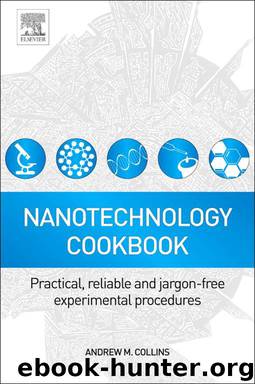Nanotechnology Cookbook by Collins Andrew

Author:Collins, Andrew
Language: eng
Format: epub
ISBN: 9780080971735
Publisher: Elsevier Science
Published: 2012-05-08T16:00:00+00:00
Preparation of Fluorescent Silver Nanoclusters
With thanks to Jamie Shenston
The colour of a colloidal solution of a gold or silver is dependant on the plasmon resonance. As has been explored previously, this collective oscillation of the conductive electrons in the metal is size dependant on the diameter of the nanoparticle. What happens then, if the diameter is decreased still further? In a similar manner to the quantisation effects seen in a semiconductor material, the behaviour of the bulk electrons in the metal begin to be determined more and more by the electronic structure of its constituent single metal atoms. As the size of the metal particle moves below the wavelength of a single electron at the Fermi level, then the electronic behaviour of the total particle becomes quantised into discrete allowable transitions. Effectively the metal particle now behaves electronically as a molecule and can undergo similar electronic interactions such as excitation. Below 2 nm the term metal ‘nanoparticle’ is swapped for ‘cluster’ and in silver clusters it is possible to observe fluorescence when these clusters are excited by UV light. It is important to recap that the fluorescence is not an effect of metallic plasmon resonance but is from the excitation of an electron and the subsequent radiative emission as might be observed for a traditional organic dye molecule in the same conditions. This electronic transition is still influenced by the size of the cluster because the number of metal atoms present will determine the level of quantisation in the electronic band structure. In this respect the electronic band structure of a metal nanocluster has more in common with semiconductor nanomaterials rather than size dependant plasmon interactions. Fluorescent clusters composed of nobel metals are also resistant to oxidation and corrosion making them good for use as markers in conditions that might destroy an organic analogue. Additionally, they do not experience blinking as with semiconductor particles.
In this recipe we will use a facile method to produce fluorescence nanoclusters of silver stabilised by poly(methacrylic acid) (Diez et al., 2009) (Diez et al., 2010). The poly(methacrylic acid) serves a number of purposes in the formation and stabilisation process. This polymer is rich in carboxylic acid groups and it would be normally assumed that the polymer would coordinate through deprontonated hydroxyls to the surface of the silver. However, in this procedure the reaction occurs at pH 3 which means the carboxylic acids retain their protons. In the acidified form the carboxylic acids along the polymer backbone will form hydrogen bonds with one another such that the polymer chains become viscous in solution. Silver ions mixed in with this viscous solution experience very limited diffusion and when reduced photolytically under UV light they stay in place within the polymer matrix. The formed metal clusters are immobilised and prevented from agglomerating to one another. The viscosity also minimises the amount of silver ions that can diffuse to the surface of another particle before they are reduced themselves. These conditions give rise to the formation of sub 2 nm clusters which will behave as fluorophores in solution stabilised by the poly(methacrylic acid).
Download
This site does not store any files on its server. We only index and link to content provided by other sites. Please contact the content providers to delete copyright contents if any and email us, we'll remove relevant links or contents immediately.
| Concrete | Extraction & Processing |
| Fracture Mechanics | Materials Science |
| Metallurgy | Polymers & Textiles |
| Strength of Materials | Testing |
Whiskies Galore by Ian Buxton(41824)
Introduction to Aircraft Design (Cambridge Aerospace Series) by John P. Fielding(33052)
Small Unmanned Fixed-wing Aircraft Design by Andrew J. Keane Andras Sobester James P. Scanlan & András Sóbester & James P. Scanlan(32735)
Craft Beer for the Homebrewer by Michael Agnew(18128)
Turbulence by E. J. Noyes(7924)
The Complete Stick Figure Physics Tutorials by Allen Sarah(7296)
Kaplan MCAT General Chemistry Review by Kaplan(6857)
The Thirst by Nesbo Jo(6815)
Bad Blood by John Carreyrou(6529)
Modelling of Convective Heat and Mass Transfer in Rotating Flows by Igor V. Shevchuk(6382)
Learning SQL by Alan Beaulieu(6198)
Weapons of Math Destruction by Cathy O'Neil(6125)
Man-made Catastrophes and Risk Information Concealment by Dmitry Chernov & Didier Sornette(5910)
Digital Minimalism by Cal Newport;(5642)
Life 3.0: Being Human in the Age of Artificial Intelligence by Tegmark Max(5455)
iGen by Jean M. Twenge(5356)
Secrets of Antigravity Propulsion: Tesla, UFOs, and Classified Aerospace Technology by Ph.D. Paul A. Laviolette(5303)
Design of Trajectory Optimization Approach for Space Maneuver Vehicle Skip Entry Problems by Runqi Chai & Al Savvaris & Antonios Tsourdos & Senchun Chai(5000)
Electronic Devices & Circuits by Jacob Millman & Christos C. Halkias(4895)
